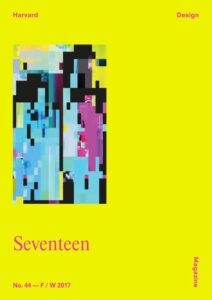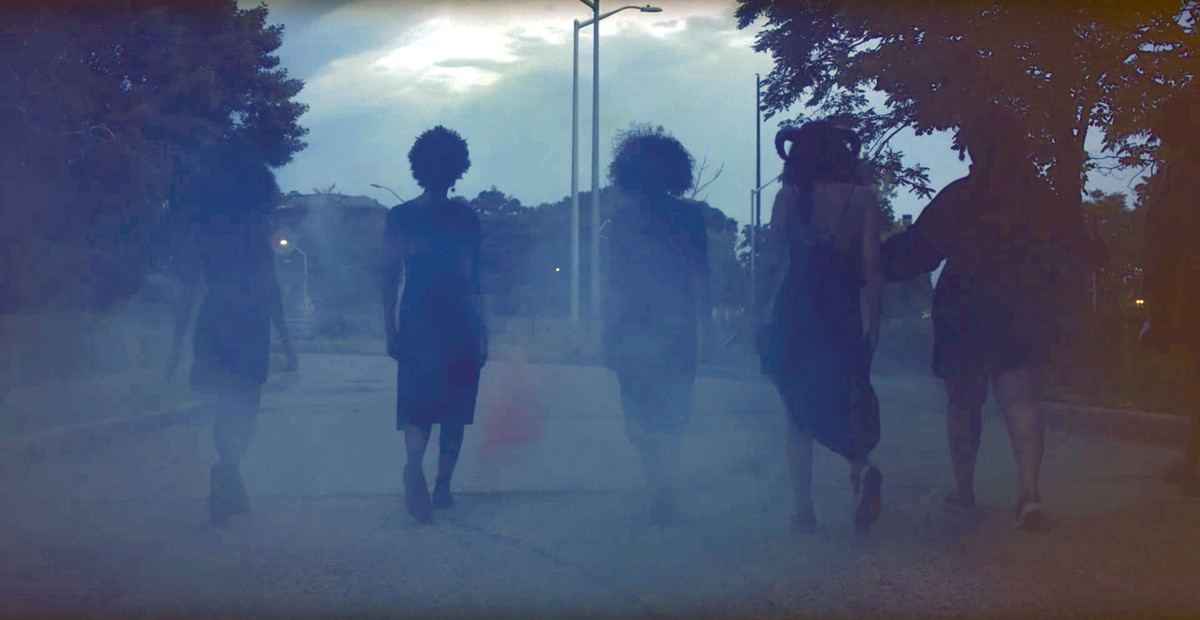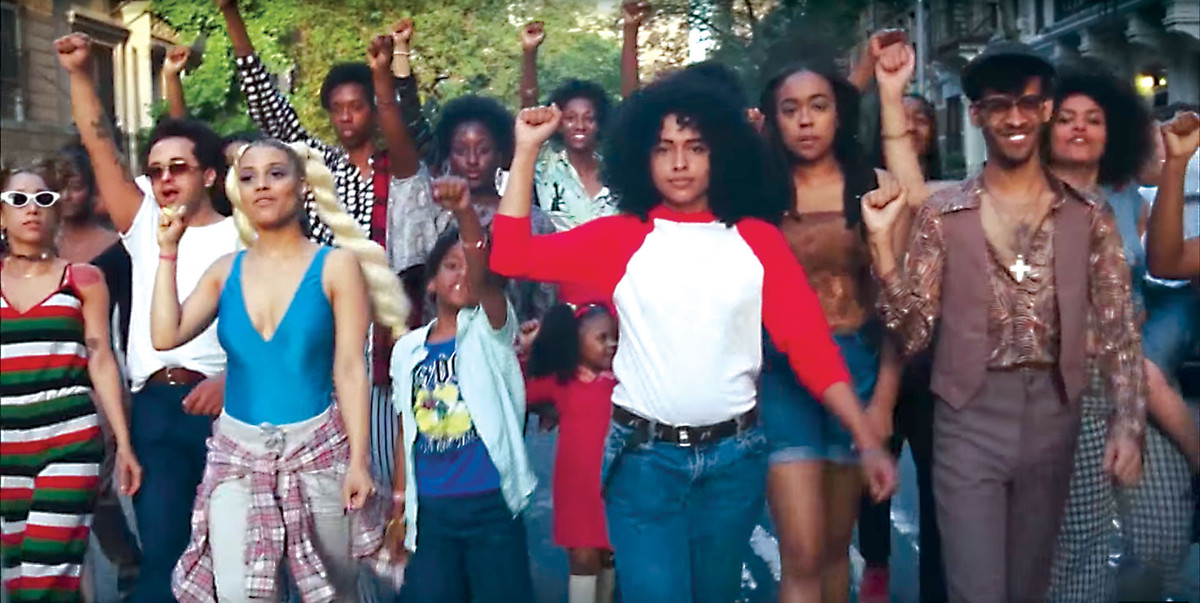“Young Girls” and Their Real Worlds
A news alert interrupts the video streaming on your phone. @realDonaldTrump cried “witch hunt,”1 but you’re using your data, so you bat away the push notification.
♫ Like . . . is any of this for real?
Princess Nokia resumes the chorus of “Anomaly” (2014) and you fall back into yourself. Didn’t anyone make this dude read The Crucible?2
♫ I’ve got space and time on my mind I’ve got bigger things to do
I’ve got voices in my head
They’re exploding with the truth
To live in America’s 2017 is to feel the creep of some new unreality. Not the applied fakeness that delights and sustains us (eyelash extensions and the Onion and all), but inventions that unsettle our common foundations of being and truth. With little respite from the 24-hour news cycle—fake or not—we’ve witnessed bastions of objectivity consecutively undermined by the terror of the alternative fact. The structure of reality itself has become a partisan issue, a thing now negotiated in the press, on reality TV and Twitter, or in cross-borough conversations with your Uber driver (“Do you ladies even remember the Clinton administration?”).
As a thing now withdrawn into the realm of debate, reality is invoked to foreclose other existential and ontological positions (“be realistic”). At the ends of these arguments, what we find is that the real is never secure but only propped up by efforts to produce and enforce its ordering—bases for exclusion rather than admission.
Designers find it especially hard to resist the conflation of the built and the real. As technicians of both science and art, we are granted the tools of objectivity and the bid to imagine otherwise, as long as that imagination resolves back into building. Fakeness is invited into this schema as a material effect, something layered onto a reliable substrate—some tromp l’oeil that makes you forget for a moment the masonry blocks beneath. These underlying brick-and-mortar logics don’t just qualify reality within the world of materials and material processes but remind you that the architect is responsible for the house you live in, the house you desire, the one you have not yet imagined. But even as arbiters of both reality and invention, architects are curious bystanders in this time in which a wall can proceed as a matter of policy.3 This “big, beautiful, powerful wall”4 is a fantasy to concretize a set of power relations in flux, one conjured by the ego of a single billionaire and the growing xenophobia of a voting public unrecognizable to us as America. Is this the dream shared by a country of immigrants? Those who would endure the mal- or well-intentioned plans of white men to build a thing as unbelievable as a nation? The real has always been political.
In the convergence of late capitalism and hyper-individualization (of labor, of information, of consumer goods) with a protracted hetero-patriarchy, an increasingly reconfigurable reality has been made available to the men who have long defined the world for themselves.5 Meanwhile, women, people of color, and queer people have been working at their own mythologies against the (un)realities that have reciprocally fashioned their disadvantage. Such acts of self-invention and their associated identity politics are often born in the contexts of art, literature, and music, but are largely cordoned off from banal inventions of power by a privileged and uninspired class of bureaucrats and entrepreneurs. The position of the young girl is particularly limited, even in the optimistic staging of liberal democracy.6 The character of the teenage girl, seen texting from the backseat of an SUV in a car-insurance commercial, is a thing to be entertained until she can prove herself useful. So what does it mean for her, the girl who is not this girl, to grow up here, in reality’s elsewhere? To be young and full of possibility in an unreal terrain?

Well, who is better, who is more adaptable, than the young girl to attend to political and existential fantasy? Teenagers, especially girls, are masterful technicians of invention because they must constantly assert themselves against an identity defined on their behalf, one figured as a lack (of experience, resources, or productivity).7 Spatial and social forms of self-invention have long been deployed by the teen girl because and in spite of her disempowerment. Fashion blogs,8 Lolita tea parties,9 and Harry Potter fan fiction message boards10 list among teen girls’ efforts to inhabit universes that exist for and by them. But productive fantasies— alternate mappings of self and space that become operative in the world of objects or that work to free subjects from fixed social conditions—have been constructed by young women (and trans and genderqueer youth) to adapt not just themselves but their environments (social, physical, intellectual) to their own alterity. These operations of identity don’t play out in some impossible space but are enmeshed in the spatial and social contexts from which they emerge.
Alternative, fantastic, and mystical realities provide experiential and not just rhetorical bases for survival, self-care, and radical re-presentation against a denial of humanity. Here, we examine the unreal not as a condition of improper evidence or veracity, but as a refusal of the circumstances—built and otherwise—that determine one’s position in the world. In this sense, we can regard constructions of realities by and for teen girls on their terms and in the same frame as figments of national security (“a nation without borders is not a nation,” Trump asserted at John Kelly’s Department of Homeland Security nomination11). In this moment of reality’s heightened plasticity, whose radical new truths and self-authorizing reconstructions of the world can take effect?
As a young (not teenage) feminist practice, we find it important to admit into the world of architecture the forms and necessities of fantasy, dreaming, and escape, and all of the makings and un-makings of self and space that might disrupt staid operations of the real. In fantasizing outwardly, in service to a public who is more often disempowered than liberated by built reality,12 we might generate more nuanced spatio-political operations with or on behalf of young women, queer women, and women of color. Gestures away from walls and toward more performative actions might unmoor spatial practice from its dangerous position as a value-added service that qualifies, enforces, or dresses the ordering of political reality. Rather, projects guided by teen dreaming can come to bear on the design of a more equitable “real world,” one we all live in. Young girls, they are the patrons of this earth.13
♫ Time and time again
I started wars in the heads of men I am a woman
I do not break, I bend
I’m sent to heal
Angels are real
And the world is real
In our discussion of the unbecoming of the real, we turn to a contemporary sorceress. Destiny Frasqueri is a 25-year-old Nuyorican artist who started recording music at 17. She has released work since 2010 first as Wavy Spice, but has gained significant fame as Princess Nokia. The latter nom de guerre embodies a constitutive identity, an initial act of self-authoring that establishes her terrain of operation and her relationship to a world of women dispossessed by authoritative constructions of the real. She states, “As Princess Nokia I can project the multidimensional aspects of myself that I could not express with the name Wavy Spice. I can venture into any realm of music or character of my choosing without confusion. I’m making worldly music—music that will talk to all kinds of people. Banjee girls in Harlem, teen brides in the Middle East, gay boys in East Asia. Labels no longer matter. My new music is cosmic and three-dimensional, and it will really speak of who Princess Nokia is. Princess Nokia is sound. It is progression. It is all that I am.”14
She’s a club kid from the Lower East Side, a bruja from Spanish Harlem, a “Samantha Jones kinda bitch” with a “seven-G loft in Tribeca,”15 and a cyborg feminist of some digital origin. She tours internationally, performing at colleges and at all-ages shows in small clubs, where she insists on maintaining a safe space for the young women who’ve come to see her, asking cis men to stand in the back and be respectful. She’s spoken at Harvard, at “chill lectures” with institutional and informal audiences, and on her own radio show in meditative monologues directed toward her club of smart girls.16 The consistent frame for her multiple designs on self is the music video, a spatial-imaging apparatus through which she negotiates her own multiplicitous identity and recognizes those of others. These identities are as tied to space as they are to one another, involving the girls who appear in a scene on 7th Street and Avenue D, those on set for its production, and a viewing public that performs and enjoys its own recognition.
♫ I just wanna have fun and to live without fear
I put the ground to the ear and claimed that this was
my year
Princess Nokia offers a fantasy space, one that explodes the windowsill of passive daydreaming often associated with teens. While the scenographies of her videos repeatedly indulge in the escapism of early 2000s nostalgia, video games, and anime, these unreal productions presuppose an audience that also needs relief from a reality that is not (only) boring but confining. Princess Nokia’s productive fantasies bring the world of reflexive dreaming into an active, collective space where the unseen or unacknowledged worlds of banjee girls, teen brides, and gay boys can be apprehended, experienced, and recreated by viewers. She signals to other Lower East Side kids who have walked this stretch of 7th Street that they can do so with the same self-possession—that this site, a block of public housing, is different in her visioning of it. Her designs on shared fantasy become particularly operative in her restagings of the spiritual practices of Santeria and Yoruba. These songs and videos (namely “YAYA” [2012], “Young Girls” [2015], and “Brujas” [2016]) join a long lineage of myth-enacting rituals that designate worlds and ways of being beyond the ordering of colonial space, and which have survived in spite of and because of their invisibility. Princess Nokia engineers the re-presentation of ritual spaces as newly accessible retreats, available to broad audiences on platforms like YouTube. The videos are made not only for an affirming gaze, but they appeal to a public who shares in that visibility, who is invited to reimage and reimagine the real and to participate in self-definitions that are both personal and common.
The videos are themselves feminist works, but their productions also constitute feminist spaces that specifically accommodate young women of color among the broader, whiter representation of feminist discourse and within a site of cultural production in New York that has failed to advance women artists or the work of QTPOC (queer and trans people of color). Coproduced with her friends and peers, including longtime collaborator Milah Libin, the videos allow Destiny to formalize her relationships into expansive alliances with other women. Destiny and Milah are cofounders of Smart Girl Club, which among other activities is responsible for producing Princess Nokia’s videos. The collective serves as a means by which women can convene around shared experiences of the city, even if they’ve found one another online. Their urban feminism is marked by a collaborative production of self and space:
The idea of the collective is what matters most. The initial creation of Smart Girl Club was to provide a safe space for women to not only create art, but also engage in a discourse about what it means to exist in this world, the struggles that come with adversity, and to just have fun and meet others like us! Although it’s a vessel in which we can put out work, such as music videos, zines, etc. the main objective is to create an environment, whether it is physical or on the Internet, that young women of ALL backgrounds can feel completely safe and accepted within.17
Destiny renders her own appearance and the appearance of other women of color within environments built despite them. As Princess Nokia, she reorganizes space by mythic reoccupation in and beyond the city. Videos like “Young Girls” enact her feminist utopia not in some elsewhere, but blocks away in a secluded part of Central Park.
In this intimate outside, she celebrates the young girl and the teen mother, figures whose value and agency are under-acknowledged across legitimating forums.18 Here, the young girl is remade, reasserted, and renewed in the staged environs of her peers, her mother, her ancestors—environments that otherwise have not or could not exist for them. Auto-poietic occupations of the street, the stoop, the basketball court, a highway overpass, the stairwell of her grandmother’s apartment—each locate Princess Nokia in an appended version of the city that made her.19
In the 2016 banger “Tomboy,” Princess Nokia voices and answers the question of the viewer, a surrogate for the male gaze: “Who that is, hoe? That girl is a tomboy.” Positioning her body—“My little titties and my phat belly”—as concertedly visible in an urban domain that is hers by proclamation, she renders an assemblage of Manhattan where her body is her own. These public becomings proceed in contrast to designs on the typical spatial proxy for the teenage girl: the plush and postered interior of her childhood bedroom. This trope-space delimits teenage expression and influence to a narrowly defined and privileged domestic space. In “Tomboy,” the city is appropriated as newly personal space, marked not just by Princess Nokia’s visible occupation but, in its reframing, as constituent of her identity and community.
The video for “Soul Train” (2015), released under Destiny’s full name and directed by another close collaborator Asli Baykal, is a nostalgic restaging of black performance in the frame of the street. An ode to the long-running production of the same name—in which dancers and musicians entered the living room by way of a Hollywood studio set—Asli and Destiny’s “Soul Train” reasserts the urban environment as a site of intersubjectivity and appearance, where exuberant bodily presence reorganizes the traffic and policing of the street, making space for vital expression instead.
Produced spaces of representation—the studio, the set, and the immobile screen—cease to be closed frames from which the artist is heard. A generation raised on reality television yearns for an escape that registers or reintegrates with the space of experience. The music video environments from Destiny’s childhood are unfamiliar and unworldly spaces: TLC’s and Missy Elliott’s early 2000s spaceships offered escapist experiences for city and suburban viewers alike. But the three-dimensionally rendered headquarters for Destiny’s Child’s “Independent Women” (2001) is now exchanged for Beyoncé on top of a car in a flooded New Orleans in “Formation” (2016), more than a decade after Hurricane Katrina. As the ground for reinvention rather than pure escape, Princess Nokia’s urban terrain becomes malleable in her and her collaborators’ imaging.
Destiny’s position in a wave of bruja feminism is one as equally footed in a Lower East Side skatepark as it is in Puerto Rico (or a hidden part of a Manhattan park meant to recall the other island). This diaspora is imaged across other videos that orchestrate intensely personal occupations of natural environments. There, women convene with nature in a way that channels power, houses ritual, and makes space. The video for “Brujas,” also directed with Asli, presences bodies real and mythical to call into being an interiority within “the wild”—an environment conventionally rendered exterior to the urban. “Brujas” (witches, or also, bitches) is a tribute to her ancestors: generations of Native American, Puerto Rican, and African women who practiced Yoruba and Santeria, as interlocutors in a place beyond the wild.
Queer theorist Jack Halberstam describes this “wild beyond” as “not simply the left over space that limns real and regulated zones of polite society; rather, it is a wild place that continuously produces its own unregulated wildness.”20 The wild as concept and material feeds the project of colonialism: it provides the oppositional foundation from which the urban emerges and provides the raw materials to make and sustain the city. The wild is the space, the cultures, and the identities subjugated by the production of capital, but the wild beyond is a space of something more, one that’s actively produced. Princess Nokia’s wilderness not only revitalizes, protects, and nourishes the self but also scenes productions of self otherwise inhibited by the city. Hand in hand with other women, she displaces this interior from an urbanity signified by capital accumulation and violence to one signified by the agency of Afro-Latina women. Urban feminism remakes the wild that both designates and is left over by colonial society. This new space of being-in-power exists within and exceeds the spaces of capital, where women produce more wild as an act of refusal.
The opening scene in “Brujas” images the sacred space of a Yoruban orisha, or spirit, who creates and is created by the lake. She is framed by the arms of brown women facing her, a space of dialogue between their bodies. We look onto this private moment around the veil of the orisha from just over the shoulders of the women.21 We can’t see her face, but we don’t need to. The moment affirms their mutually constructed visibility and power. The landscape is a space of emergence transformed by the presence of the orisha, whose body is both of and out of the water; without her body there is no interiority.
These retreats into the wild elicit spaces of self-care that transcend time, something replicable elsewhere, in your headphones on a crowded 6 train. In the last scenes of the video, veils are exchanged for fog as the brujas reenter the space of the city. There, they face outward and meet viewers head-on. As Princess Nokia states, “I’m a shape-shifting bitch, you don’t know who you’re loving.” In the diasporic space of the music video, she acknowledges preexisting myths from traditionally oral cultures and enacts new ones to be occupied and imagined by a generation of networked viewers. “Brujas” asserts the authority, contemporaneity, and materiality of mythological space to affirm indigenous historicities and resist their folklorization, instantiating a space where, as she says, “I can vanquish your spite.”
Princess Nokia’s brujas and young girls are the women of a utopic reality, a place of power, fomented even in its impossibility. Their inventions and ambitions offer a necessary antidote to both “master builder” Trump and a design profession that is expected to be complicit in his agenda. And by navigating other worlds of practice, particularly those that put architecture’s processes of evidence making and representation to better use, we can better engage in more generous productions of identity and reality in a world still made by men of privilege. We can exploit the intermediary position architects often enjoy between publics and the institutions and entities that authorize work, to locate new responsibilities to design protest, reinforce bodily autonomy, and choreograph access to spaces for people “to have fun and live without fear.”22 Of course this also involves establishing new alliances within the field.
Young girls are the patrons of the earth, Destiny writes, so why wouldn’t they be our clients and coproducers? In a field that has few women of color and no longer has a Zaha (a reluctant hero anyway), Destiny and her collaborators are the designers we’d like to see in practice, as part of our own productive fantasy. As we look up to Princess Nokia, in a photo torn from Teen Vogue and taped over our desks, we deploy her methodologies and seek out opportunities that call other young women into visibility as a producing public. Their engagements against nationalist projects are already playing out in the streets, in moments of joy and bravado as they stare down cops and neo-Nazis, as they walk out of classrooms en masse, as they remind you to “say her name.”23 Beyond the procedures that advance the built, we find these women already fashioning the world they need to exist—by whatever means necessary. What we must do is model a practice that never existed for us, one that might compel college-facing women to become architects not because they are drawn by a tradition of building, but because architecture practice can expand their ability to occasion more equitable futures.
feminist architecture collaborative (also called f-architecture) is a three-woman research enterprise aimed at disentangling the contemporary spatial politics and technological appearances of bodies, intimately and globally. Partners/caryatids/BFFs Gabrielle Printz, Virginia Black, and Rosana Elkhatib run their practice out of the GSAPP Incubator at NEW INC, an initiative of the New Museum.




